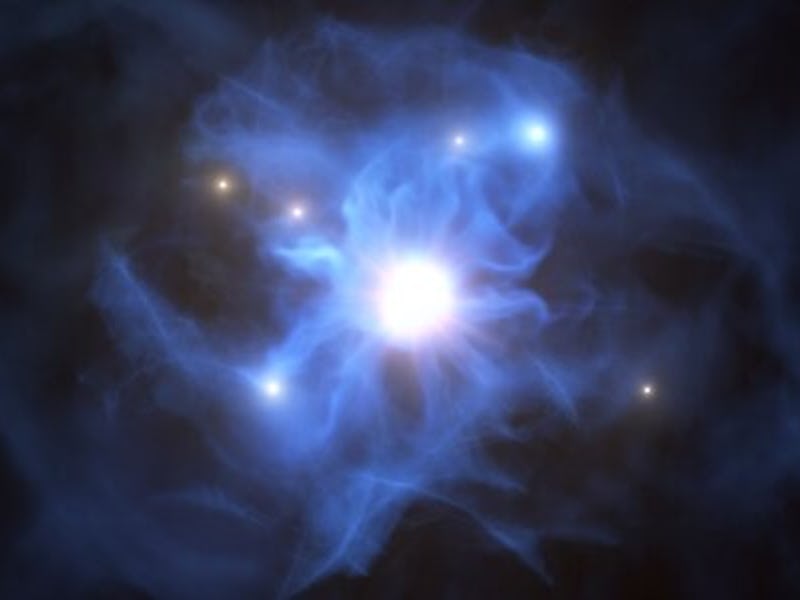Scientists discover six galaxies entangled in an ancient black hole's web
A new study hints at how the universe' mysterious behemoths grow to be so massive.

Tucked within the deep center of galaxies, massive black holes lurk in the shadows and feed off of matter that dares come near. Some black holes go a step further, forming a web-like structure of galaxies, sucking the gas out their captured prey to grow even more massively in size.
Now, astronomers think they have spotted a first-of-its kind incident. Six galaxies caught in the web of an ancient black hole, at a time when the universe was in its infancy, less than a billion years old. It is so old, in fact, that this first grouping to be seen so early in the span of the cosmos.
The new discovery was detailed in a study published Thursday in the journal Astronomy and Astrophysics. The data will allow scientists to better understand how these cosmic beings evolve over time and grow in size.
The team of scientists behind the new study spotted this galactic grouping using the European Southern Observatory Very Large Telescope. Altogether, the group extends over an area of the cosmos 300 times the size of the Milky Way galaxy.
Inside a spider web-like structure of gas filaments, there lies a group of six galaxies surrounding a supermassive black hole. The black hole itself is one billion times larger than the Sun.
An artist's impression of the web of gas filaments that surrounds the ancient, massive black hole.
“The cosmic web filaments are like spider’s web threads,” Marco Mignoli, an astronomer at the National Institute for Astrophysics (INAF) in Bologna, Italy, and lead author of the new study, said in a statement. “The galaxies stand and grow where the filaments cross, and streams of gas — available to fuel both the galaxies and the central supermassive black hole — can flow along the filaments.”
The universe formed 13.8 billion years ago. But this structure exists at a time when the universe was only 0.9 billion years old, with its bright light traveling across billions of years to reach Earth.
“Our work has placed an important piece in the largely incomplete puzzle that is the formation and growth of such extreme, yet relatively abundant, objects so quickly after the Big Bang,” Roberto Gilli said in a statement. He is also an astronomer at INAF in Bologna and co-author of the new study.
Astronomers believe the black holes of the early universe must have grown at a much faster rate than their later counterparts, which include the black hole at the center of the Milky Way which is four million times the mass of the Sun.
But they had been unable to explain how these ancient black holes acquired so much 'nutritional fuel,' or surrounding matter, to be able to reach their size in a short amount of time.
This new observation provides one possible explanation, that these web-like structures of galaxies contain enough gas to fuel the early black holes' growth into a supermassive beast.
Additionally, the researchers behind the new study believe these structures formed due to dark matter, the mysterious force that makes up the majority of the universe and holds objects together through gravitational pull.
Dark matter in the early universe attracts huge amounts of gas, and could be the invisible link holding the structure of gas filaments together.
Abstract: We report on the spectroscopic confirmation of a large-scale structure around the luminous z=6.31 quasi-stellar object (QSO) SDSS J1030+0524, powered by a one billion solar mass black hole. The structure is populated by at least six members, namely, four Lyman-break galaxies (LBGs), and two Lyman alpha emitters (LAEs). The four LBGs were identified among a sample of 21 i-band dropouts with zAB< 25.5 selected up to projected separations of 5 physical Mpc (15 arcmin) from the QSO. Their redshifts were determined through multi-object spectroscopic observations at 8-10m class telescopes lasting up to eight hours. The two LAEs were identified in a 6hr VLT/MUSE observation centered on the QSO. The redshifts of the six galaxies cover the range between 6.129-6.355. Assuming that the peculiar velocities are negligible, this range corresponds to radial separations of ±5 physical Mpc from the QSO, that is comparable to the projected scale of the observed LBG distribution on the sky. We conservatively estimate that this structure is significant at a level > 3.5σ and that the level of the galaxy overdensity is at least 1.5-2 within the large volume sampled (∼780 physical Mpc3 ). The spectral properties of the six member galaxies (Lyα strength and UV luminosity) are similar to those of field galaxies at similar redshifts. This is the first spectroscopic identification of a galaxy overdensity around a supermassive black hole in the first billion years of the Universe. Our finding lends support to the idea that the most distant and massive black holes form and grow within massive (> 1012 M ) dark matter halos in large-scale structures and that the absence of earlier detections of such systems is likely due to observational limitations.